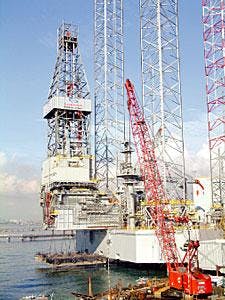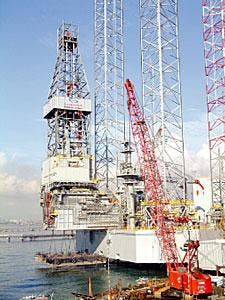The US rig count plunge during the first week of August—the biggest 1-week loss since early November 2002—prompted questions as to what part, if any, Houston-based Anadarko Petroleum Corp. may have played in that fall.
Anadarko shook up the oil services industry July 31 when it announced it would eliminate 400 jobs and close offices in Amarillo and Midland, Tex., to cut its annual costs by $100 million (OGJ Online, Aug. 1, 2003).
The company said it dropped at least 7 land rigs that same week, as some of its planned drilling projects were completed. "That's the nature of our business. We were down to 25 rigs at the end of last year before going back up to 66," a company representative told OGJ.
The Anadarko factor
So when the US rig count fell the following week by 23 rotary rigs to 1,074 still working, Grant Borbridge, an analyst in the Palo Alto, Calif., office of Prudential Financial, a subsidiary of Prudential Insurance Co. of America, put the primary blame on rigs released by Anadarko.
Although "we believe that these rigs should be recontracted rather quickly, while they are in transit, they will not be counted in the rig count," said Borbridge in an Aug. 11 report. Other industry sources, however, reported that the rigs released by Anadarko were offset by increased demand for rigs among other independents, with no apparent effect on the total US drilling activity.
In fact, on Aug. 1, the day after Anadarko said it had released 7 rigs, Baker Hughes Inc. reported the US rig count increased by 6 rotary rigs to 1,097 units working that week, the highest level since early October 2001.
The Aug. 8 drop in the rig count was the result of several "temporary" factors, such as some rigs being moved to new drilling sites and others drilling shallower wells than the 3,500-5,000 ft minimum projected TD—"depending on the district"—required for being registered in Baker Hughes rig count, officials said. "We're not worried. It will come back up," a company spokesperson told OGJ (OGJ Online, Aug. 8).
That same week, EOG Resources Inc., Houston, announced plans to increase its active rig count by 56% to 50 rigs in the second half of this year because of the bullish outlook for the US natural gas market.
- GlobalSantaFe Corp. recently took delivery of its high-performance jack up rig Constellation I, which is now working in Southeast Asia. The American Bureau of Shipping has released a detailed technical commentary to its Rules for Building and Classing Mobile Offshore Drilling Units (MODUs) to facilitate continued development of newly designed jack up rigs, such as the Constellation I, that are necessary for frontier development and improved drilling efficiency. Photo courtesy of the American Bureau of Shipping.
The company raised its projected capital spending for this year to $925 million-$1 billion, excluding acquisitions, from previous levels of $825-950 million, "after claiming early in the year it would not increase its spending plans," said analysts at Jefferies & Co. Inc., New York.
"This is a positive sign for oil service investors, and it strongly supports our belief that Anadarko news was company-specific," they said. They foresaw "solid fundamentals" for the drilling industry, "including an underlying natural gas delivery problem in the US."
In a subsequent discussion of its second quarter results, Devon Energy Corp., Oklahoma City, said it has essentially completed the integration of Ocean Energy Inc. and expects to realize at least $50 million in annual cost savings. As a result, it expects to accelerate the pace of exploration during the second half of this year with six high-potential deepwater Gulf of Mexico prospects currently drilling and three more ready to spud before yearend.
In addition, Devon increased to 70 from 50 the number of horizontal wells it plans to drill this year in the Barnett Shale play in Central Texas, with up to 30 of those targeted outside the core area where significant potential exists.
Drilling permits
Meanwhile, filings for drilling permits in the 30 monitored states increased by 4.8% in July from June levels, adjusted for comparable numbers of filing days, said Angeline M. Sedita, vice-president of oil service equity research at Lehman Bros. Inc., New York.
"This month's improvement was led by Michigan, New Mexico (up 44%), and Kansas (up 33%)," she reported Aug. 8. "The steady climb in permitting activity in recent months suggests a continuing modest climb in the [US] rig count over the remainder of 2003."
Despite the drop in the US rig count during the first week of August, Borbridge noted that US land drilling activity was up 31% from the same period in 2002.
Additionally, he said, "We believe that we have reached the inflection point for an increase in Gulf of Mexico offshore activity, as indicated by the upward trend in the number of offshore drilling permits being issued in the past 4 months, together with higher effective utilization in the Gulf of Mexico. At 120, the Gulf of Mexico's supply of jack ups is at a 10-year low."
The second half of this year, he said, "should exhibit marked increases in both day rates and utilization."
Wayne Andrews, an analyst in the Houston office of Raymond James & Associates Inc., St. Petersburg, Fla., noted in an Aug. 11 report, however, that US natural gas production continues to fall despite a 30% increase in drilling activity in the past year. "Drilling activity among the majors and gas utilities has actually declined by 11% since the start of the year," he said.
"This brings to light an even more astonishing reality: The independents and 'mom-and-pops' are driving all of the drilling activity increases, with little production response to show for it."
Bullish price outlook
As a result, Andrews said, "Our bullish thesis has been and continues to [center on] the underlying problem of falling US natural gas production. Much like in the 1970s, when oil production continued to fall regardless of how many rigs were drilling, we think we are nearing (if not at) a similar crossroads in the US natural gas supply picture.
"Given the inherent rate of decline in US natural gas wells today, combined with what is still a muted response to drilling activity, we expect natural gas production levels to continue trending south for the next several quarters."
That and persistently high oil prices "should keep average US natural gas prices in the $6/Mcf range," he said. "Furthermore, even with an unforeseen pullback in oil prices, we would expect at least $5/Mcf average natural gas prices for the foreseeable future."
At the time of Anadarko's announcement, James K. Wicklund, an oil services analyst in the Houston office of Banc of America Securities LLC, said, "We do not think this is the beginning of a trend, but rather one company that got way off track. Generally, more companies are announcing increases in drilling budgets."
Moreover, he said, "One point has been ignored. Anadarko was listed as the most active oil company in the US with about 50 rigs running just a few weeks ago. That gives Anadarko about 4% of the market. If the most active company has only 4% of the capacity, then the breadth and depth of the active drillers [are] dramatic."
Nevertheless, said Wicklund, "No business can go through an unexpected, unbudgeted, unplanned 30% increase in business in 6 months and not need to slow down and consolidate gains.
"The US drilling rig count will stall and maybe even drop some. It will pick up again in the December quarter as budgets are wound out and the partnerships drill up intangible write-offs to shelter a very good year of income."
Wicklund expects the US rig count through this year to be up by 27-29% from 2002. "Drilling will increase again next year as continuing high natural gas prices continue to drive more drilling in order to bring supply [and] demand into better balance than just for a single storage season," he said.

